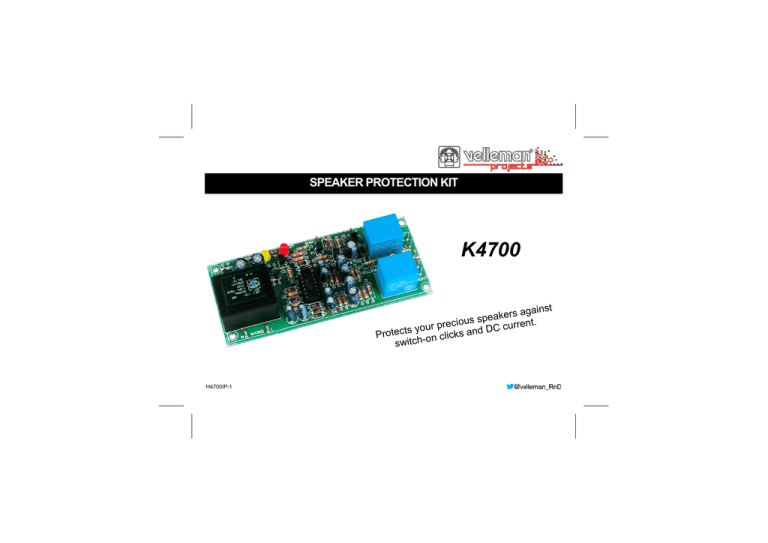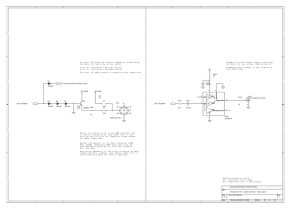speaker protection kit
advertisement

SPEAKER PROTECTION KIT K4700 ainst kers ag a e p s s ciou ent. your pre DC curr Protects -on clicks and switch H4700IP-1 VELLEMAN NV Legen Heirweg 33 9890 Gavere Belgium Europe www.velleman.be www.velleman-kit.com Features & Specifications Features This stereo loudspeaker protection will protect the loudspeakers against the switch-impulsions and the direct current component on the output of the connected amplifier. Suitable for: * Amplifiers with symmetrical power supply * Amplifiers with asymmetrical power supply. Specifications : Switch-delay: ± 6 seconds DC protection: +1V/-1V Max. input voltage: 200Vpp + DC Max. switching current: 10A LED indication for: WAIT (switch-on delay) and ERROR (DC on speaker output) Supply voltage: 220VAC PCB dimensions: 55 x 125mm (2.2" x 4.9") 3 Assembly hints 1. Assembly (Skipping this can lead to troubles ! ) Ok, so we have your attention. These hints will help you to make this project successful. Read them carefully. 1.1 Make sure you have the right tools: A good quality soldering iron (25-40W) with a small tip. Wipe it often on a wet sponge or cloth, to keep it clean; then apply solder to the tip, to give it a wet look. This is called ‘thinning’ and will protect the tip, and enables you to make good connections. When solder rolls off the tip, it needs cleaning. Thin raisin-core solder. Do not use any flux or grease. A diagonal cutter to trim excess wires. To avoid injury when cutting excess leads, hold the lead so they cannot fly towards the eyes. Needle nose pliers, for bending leads, or to hold components in place. Small blade and Phillips screwdrivers. A basic range is fine. 0.0 00 For some projects, a basic multi-meter is required, or might be handy 1.2 Assembly Hints : Make sure the skill level matches your experience, to avoid disappointments. Follow the instructions carefully. Read and understand the entire step before you perform each operation. Perform the assembly in the correct order as stated in this manual Position all parts on the PCB (Printed Circuit Board) as shown on the drawings. Values on the circuit diagram are subject to changes. Values in this assembly guide are correct* Use the check-boxes to mark your progress. Please read the included information on safety and customer service * Typographical inaccuracies excluded. Always look for possible last minute manual updates, indicated as ‘NOTE’ on a separate leaflet. 4 Assembly hints 1.3 Soldering Hints : 1- Mount the component against the PCB surface and carefully solder the leads 2- Make sure the solder joints are cone-shaped and shiny 3- Trim excess leads as close as possible to the solder joint AXIAL COMPONENTS ARE TAPED IN THE CORRECT MOUNTING SEQUENCE ! REMOVE THEM FROM THE TAPE ONE AT A TIME ! 5 Construction 1. Diodes. Watch the polarity ! 3. Diodes. Watch the polarity ! D1 D2 D3 D4 D5 D6 D7 D8 D9 D10 D11 D12 D13 D14 : : : : : : : : : : 1N4148 1N4148 1N4148 1N4148 1N4148 1N4148 1N4148 1N4148 1N4148 1N4148 D... CATHODE : : : : 1N4007 1N4007 1N4007 1N4007 CATHODE 4. Resistor R... 2. Zenerdiode. Watch the polarity ! : : : : 330K 330K 330K 330K (3 - 3 - 4 - B) (3 - 3 - 4 - B) (3 - 3 - 4 - B) (3 - 3 - 4 - B) R12 : 18K R13 : 18K (1 - 8 - 3 - B) (1 - 8 - 3 - B) R14 R15 R16 R17 (4 - 7 - 3 - B) (4 - 7 - 3 - B) (4 - 7 - 3 - B) (4 - 7 - 3 - B) : : : : 47K 47K 47K 47K R18 : 47 (4 - 7 - 0 - B) R19 : 680 R20 : 680 (6 - 8 - 1 - B) (6 - 8 - 1 - B) 5. Metal film resistor ZD1 : 6V8 CATHODE D... R8 R9 R10 R11 R... ZD1 R1 : 3K3 R2 : 3K3 (3 - 3 - 2 - B) (3 - 3 - 2 - B) R3 R4 R5 R6 R7 (8 - 2 - 2 - B) (8 - 2 - 2 - B) (8 - 2 - 2 - B) (8 - 2 - 2 - B) (8 - 2 - 2 - B) : : : : : 8K2 8K2 8K2 8K2 8K2 R21 : 100K (1 - 0 - 4 - B - 9) R22 : 100K (1 - 0 - 4 - B - 9) Construction 6. IC socket, Watch the position of the notch ! 9. Leds. Watch the polarity! IC1 : 14P LD1 : Red (ERROR) LD2 : Yellow (WAIT) 11. 1W vertical resistors R... LD1 CATHODE 7. Transistors T1 T2 T3 T4 : : : : BC547B BC547B BC547B BC517 8. PCB tabs. MAINS (N - L) +V MAN -V GND PA LEFT LS PA RIGHT LS 10. Electrolytic Capacitor. Watch the polarity ! C1 C2 C3 C4 C5 C6 : : : : : : 1µF 1µF 1µF 1µF 1µF 1µF C7 C8 C9 C10 : : : : 100µF 100µF 100µF 100µF C11 : 220µF C12 : 470µF C13 : 470µF C... If the amplifier to which the module is to be connected has a simple power supply (asymmetrical supply), i.e. an amplifier with outputelcos, the following resistances has to be mounted: R23 R24 R25 R26 : : : : 1K2 1K2 1K2 1K2 (1 - 2 - 2 - B) (1 - 2 - 2 - B) (1 - 2 - 2 - B) (1 - 2 - 2 - B) ATTENTION: if the involved amplifier has a symmetrical power supply, those resistances may NOT be mounted! 7 Construction 12. Relays 14. IC. Watch the position of the notch! RY... RY1 : VR15M121C RY2 : VR15M121C (12VDC - 15A - 1C) IC1 : LM324 (12VDC - 15A - 1C) Cover the wide connecting broad leads with solder. 13. Transformer N 6 0 L 6 TRANSFORMER Transfo 8 (1,2VA - 2 x 6V / 2 x 0,1A) CHECK THE ENTIRE MODULE PROFOUNDLY ONCE AGAIN. CHECK IF ALL SOLDERINGS ARE CORRECT AND THAT THERE ARE NO SHORT-CIRCUITS! Testing 15. Testing Connect a net-cord to the MAINS, connect the module to the net and check if after approx.+/-6 sec. the yellow LED 'WAIT' extinguishes; at the very same moment the LED is extinguishing, one should hear the clack of the relais switching. Testing the Left channel : Connect the point PA of the left channel to the point -V (figure 1.0); the red LED 'ERROR' should now be lightening together with the yellow LED 'WAIT'. When the connection is interrupted again (figure 2.0), the red LED should extinguish and after approx. +/6 sec. the yellow LED as well. Fig. 1.0 Fig. 2.0 Repeat this testing procedure by connecting the point PA to the point +V. 9 Testing Testing the right channel : Connect the point PA of the right channel to the point -V (figure 3.0); the red LED 'ERROR' should now be lightening together with the yellow LED 'WAIT'. When the connection is interrupted again (figure 4.0), the red LED should extinguish and after approx. +/6 sec. the yellow LED as well. Fig. 3.0 Fig. 4.0 Repeat this testing procedure by connecting the point PA to the point +V. The module is now ready for being connected definitively to the amplifier. 10 Connection 16. Connection First find a proper place to install the protection module (f.i. against the back-side of the housing). Realise the following connections: MAINS: this connection has to be linked to the NET-connection of the transformer in the amplifier, i.e. AFTER the net-switch! PA: connect this point to the speaker-output of the amplifier, respectively for the left and the right signal (fig 5.0). In case a bridge-amplifier (fig 6.0) is being used, there ought to be two "hot" connections here. MASS: this point has to be connected to the mass of the amplifier. LS: to this point the left resp. right loud speaker is to be connected. To disconnect the loudspeakers manually, realise the following connections: Install a switch between the points -V and MAN; when the switch is shut the speakers will be disconnected permanently, when opening the switch again after approx.+/-6 sec the speakers will be reconnected as well. REMARK. In case of amplifiers with asymmetrical power supply (i.e. having output-elcos and the resistances R23 to R26) of more than 300W/4 Ohm or 150W/8 Ohm, it is not recommandable to disconnect the speakers at full power during a longer period, because the just mentioned resistances could burn. In case the protection module is being used on a bridge-amplifier with asymmetrical power supply, the diodes D7 and D8 should not be mounted; in this case the DC-protection should not be functioning anymore because the voltage-reference of the protection-module is now opposed to the mass. 11 Connection LEFT P4700 MAINS RIGHT PA LEFT LS PA MAINS RIGHT PA LS ON/OFF ON/OFF INPUT RIGHT LS P4700 LS MAINS PA POWER SUPPLY MAINS POWER SUPPLY OUTPUT + OUTPUT RIGHT INPUT INPUT LEFT STEREO POWER AMPLIFIER 12 OUTPUT - OUTPUT LEFT Fig. 5.0 BRIDGE POWER AMPLIFIER Fig. 6.0 PCB 17. PCB layout. 13 Diagram 18. Diagram 14 VELLEMAN NV Legen Heirweg 33, B-9890 GAVERE Belgium (Europe) Modifications and typographical errors reserved © Velleman nv. H4700IP’1 - 20124 - (rev.2) 5 410329 310165

